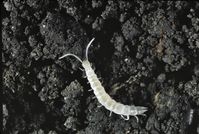

|

|
|
How to Manage PestsPests in Gardens and Landscapes
 A symphylan, sometimes called a garden centipede, but not a true centipede. The length is about one quarter that of a true centipede. Millipedes and centipedes are often seen in and around gardens and may be found wandering into homes. Unlike insects, which have three clearly defined body sections and three pairs of legs, they have numerous body segments and numerous legs. Like insects, they belong to the largest group in the animal kingdom, the arthropods, which have jointed bodies and legs and no backbone. Their bodies are covered with a shell-like covering called an exoskeleton. There are several features that distinguish a millipede from a centipede (Table 1).
MILLIPEDESIdentificationMillipedes (sometimes called thousand-leggers) are brownish, elongated, and cylindrical to slightly flattened creatures with two (more common) or four pairs of tiny legs per body segment. Millipedes don’t really have a thousand legs; even the largest ones have somewhat fewer than a hundred. When they walk, their legs move in an undulating, wavelike manner. Adult millipedes vary from 1/2 to 6 1/2 inches in length. When prodded or at rest, most millipedes curl up. The three species found in California are the common millipede, the bulb millipede, and the greenhouse millipede. Millipedes may be confused with wireworms because of their similar shapes. Wireworms, however, are click beetle larvae, have only three pairs of legs, stay underneath the soil surface, and are more flattened top to bottom. Habitat and ImportanceMillipedes normally live in and feed on rotting leaves, rotting wood, and other kinds of moist, decaying plant matter. Generally, their role is a beneficial one in helping to break down dead plant matter. However, when they become numerous, they may damage sprouting seeds, seedlings, or strawberries and other ripening fruits in contact with the ground. Sometimes individual millipedes wander from their moist living places into homes, but they usually die quickly because of the dry conditions and lack of food. Occasionally, large numbers of millipedes migrate, often uphill, as their food supply dwindles or their living places become either too wet or too dry. They may fall into swimming pools and drown. When disturbed they don’t bite, but some species exude a defensive liquid that can irritate skin or burn the eyes. Life CycleAdult millipedes overwinter in the soil, and eggs are laid in clutches beneath the soil surface. The young grow gradually in size, adding segments and legs as they mature. They mature in two to five years and continue to live for several years thereafter. ManagementMillipedes seldom need to be controlled. Keep in mind that they do no damage indoors and pose a minimal health hazard. Those that stray indoors can be swept out or picked up with a vacuum cleaner. Sealing cracks and other openings to the outside helps prevent millipedes from entering. Usually invasions are over within a few days. Eliminating moist hiding places around the home will kill or discourage millipedes. Outdoors, this includes removing rotting wood and decaying grass and leaves from around the house’s foundation. This also eliminates millipede food sources. If there is excessive moisture in subfloor crawl spaces or basements, take measures to dry out these areas. To discourage millipedes in garden areas, reduce mulch and other organic matter and avoid excessive moisture. Application of insecticides is rarely justified for millipede control. CENTIPEDESIdentificationCentipedes (sometimes called hundred-leggers) are elongated, flattened animals bearing one pair of legs per body segment. The actual total number of legs in most species is closer to 30 than to 100. Adult centipedes are usually brownish and more than 1 inch long. The house centipede, a species that commonly invades buildings, has long legs that enable it to run rapidly. Other species of centipedes more commonly found in gardens may have somewhat shorter legs. Unlike millipedes, centipedes never coil up when disturbed. Garden symphylans may be confused with true centipedes but are white, less than 1/4 inch long, and have 12 pairs of legs as adults. Symphylids live in damp soil where they sometimes attack underground portions of plants. They are associated with soils that are high in organic matter. Habitat and ImportanceCentipedes are usually found in damp, dark places such as under stones, leaf mulch, or logs. Indoors, centipedes may occur in damp areas of basements, closets, or bathrooms, or anywhere in the home where insects occur. During the day they hide in dark cracks and crevices, coming out at night to search for insects to eat. House centipedes are actually beneficial, as they capture flies, cockroaches, and other small household pests. They never damage plants or household items. When provoked, a few large kinds of centipedes can inflict a painful bite that may cause localized swelling, discoloration, and numbness. Life CycleAdult centipedes overwinter in secluded moist places. Eggs are usually placed in damp soil in the spring and summer. Some centipede species add segments and legs as they grow; others are born with a complete set. Centipedes require two to three years to mature and have been known to live six years. ManagementCentipedes seldom need to be controlled unless they become a nuisance in the home. Centipedes are predators and generally play a beneficial role in the garden. Their activities should be encouraged in the yard. Reductions in the number of household centipedes occur when their food source—other household pests—is reduced. Airing out damp places may help. Outdoors, centipede control is aided by removing debris as recommended for millipedes. Although some pesticides are labeled for controlling centipedes, the use of such products is rarely justified. WARNING ON THE USE OF PESTICIDES REFERENCEShelley, R. M. 1999. Centipedes and millipedes with emphasis on North American fauna. Kan. School Naturalist. 45(3):1–16. PUBLICATION INFORMATIONPest Notes: Millipedes and Centipedes Editor: M. Fayard Technical Editor: M. L. Flint Produced by University of California Statewide IPM Program PDF: To display a PDF document, you may need to use a PDF reader. |
||||||||||||||||||||||